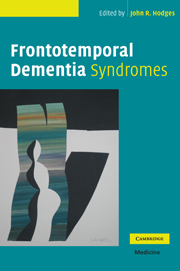Book contents
- Frontmatter
- Contents
- List of contributors page
- Preface
- 1 Overview of frontotemporal dementia
- 2 Epidemiology of frontotemporal dementia
- 3 Clinical presentations of frontotemporal dementia
- 4 Overlap syndromes
- 5 The neuropsychology of frontotemporal dementia
- 6 Neuroimaging and other investigative findings
- 7 The histopathology of frontotemporal dementia
- 8 Molecular neuropathology in familial and sporadic frontotemporal dementia
- 9 The genetics of frontotemporal dementia
- 10 Psychological interventions in frontotemporal dementia
- Index
9 - The genetics of frontotemporal dementia
Published online by Cambridge University Press: 05 August 2016
- Frontmatter
- Contents
- List of contributors page
- Preface
- 1 Overview of frontotemporal dementia
- 2 Epidemiology of frontotemporal dementia
- 3 Clinical presentations of frontotemporal dementia
- 4 Overlap syndromes
- 5 The neuropsychology of frontotemporal dementia
- 6 Neuroimaging and other investigative findings
- 7 The histopathology of frontotemporal dementia
- 8 Molecular neuropathology in familial and sporadic frontotemporal dementia
- 9 The genetics of frontotemporal dementia
- 10 Psychological interventions in frontotemporal dementia
- Index
Summary
Introduction
The importance of genetic factors in dementias which primarily affect the frontal and temporal lobes has been recognised since the 1920s but little progress was made in understanding these factors until the mid 1990s. Since then progress has been extraordinarily rapid with an unprecedented series of discoveries initially related to the MAPt gene on chromosome 17, but more recently involving cases with ubiquitin-positive disease and a previously unsuspected candidate gene, progranulin, also located on chromosome 17 close to the MAPt gene.
The first large pedigree with autosomal dominant inheritance of a frontotemporal dementia was a Dutch family described by Sanders and colleagues in 1939 under the rubric of familial Pick's disease (Sanders et al., 1939). Further studies of the same family were undertaken by Groen and Endtz (1982) who reviewed 26 other clinically similar families. A huge number of pedigrees with a familial form of frontotemporal dementia have been reported over the last 20 years, the vast majority showing autosomal dominant inheritance. The difficulties in tracing familial late onset dementias may have prevented the discovery of recessive forms of genetic FTD. Although traditionally divided into sporadic and familial this dichotomy may also be artificial. There are almost certainly important genetic influences in “sporadic” FTD mediated through a number of different genes (polygenic influences) each of which can promote the development of FTD. The separation of FTD into genetic and sporadic is likely to be a matter of degree rather than an absolute distinction.
Nomenclature in familial FTD
Recent authors have started to follow a standardised way of abbreviating familial FTD (Hardy et al., 2006): after FTD, P is added if parkinsonism is a prominent feature. Then the chromosomal linkage is added after a hyphen. If there is tau pathology then a T is added or if there are ubiquitin-positive tau-negative inclusion bodies a U is added. So FTDP-17T means FTD with parkinsonism linked to chromosome 17 with tau pathology; FTD-17U means FTD linked to chromosome 17 with ubiquitinated inclusion bodies.
The nomenclature has evolved as knowledge has advanced. This can be confusing and is best illustrated by a case of a patient with a tau mutation within the original pedigree described by Lynch et al. (1994) (see Section 5.1). Initially his disease was known by the clinical acronym DDPAC (dementiadisinhibition- parkinsonism-amyotrophy complex).
- Type
- Chapter
- Information
- Frontotemporal Dementia Syndromes , pp. 257 - 276Publisher: Cambridge University PressPrint publication year: 2007



